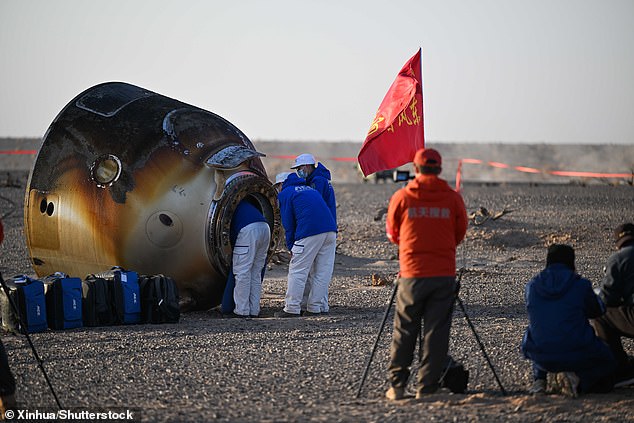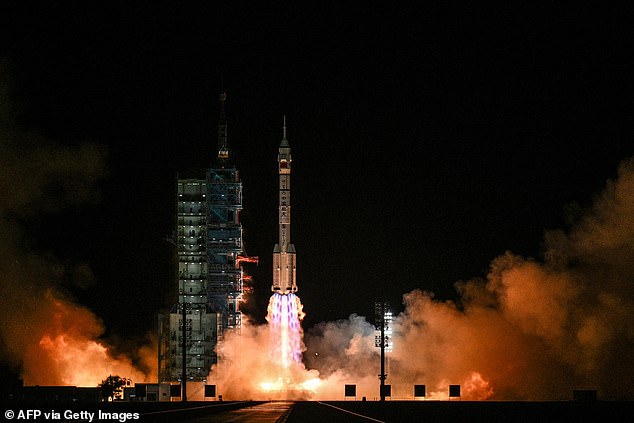Three astronauts who were stranded in space for over a week have returned to Earth, but their escape plan has left a new group of explorers without a way to get home.
Astronauts Chen Dong, Chen Zhongrui, and Wang Jie were trapped on the Chinese station Tiangong for nine days after an unknown object damaged their spacecraft so severely that it was deemed unsafe to fly in.
The three astronauts were seen landing safely in the Gobi Desert in northern China early Friday morning after their six-month mission on board the space station.
When the crew discovered cracks in the window of Shenzhou-20, Chinese officials decided to bring the three men home in the Shenzhou-21 space capsule, the craft which carried their replacements to the station on October 31.
However, that decision has now left the crew of Shenzhou-21, astronauts Zhang Lu, Wu Fei, and Zhang Hongzhang without a vessel to return to Earth in case of another space emergency.
On Friday, the China Manned Space Agency (CMSA) announced that the Shenzhou-22 spacecraft will be launched ‘at an appropriate time in the future,’ with the likely goal of bringing replacements for the Shenzhou-21 team.
That future mission wasn’t scheduled to launch until April 2026, but the space agency hasn’t said if that timeline has changed since Shenzhou-21 was due to remain in orbit for six months.
The current situation now mirrors the 286-day saga of NASA astronauts Suni Williams and Butch Wilmore earlier this year, who lost their ability to get home when mechanical problems made their space capsule unsafe to use again.

Astronaut Chen Zhongrui exited the Shenzhou-21 space capsule on November 14 after a nine-day delay caused by space debris damaging their original spacecraft

Shenzhou-21 (Pictured) carried the replacement crew for the three stranded astronauts. That crew will now have to wait for a new vehicle to be sent to space
The stranded crew of Shenzhou-20 was supposed to head home on November 5 using their own ship, but right before their departure, an object that’s believed to have been space debris hit their return capsule.
The astronauts on the station originally reported seeing a noticeable mark left on Shenzhou-20’s hull, but CMSA later announced that tiny cracks had been discovered in the ship’s window.
‘The Shenzhou-20 spacecraft does not meet the requirements for the astronauts’ safe return and will remain in orbit to continue relevant experiments,’ CMSA said, according to state-run news outlet Xinhua.
Although the crew of Shenzhou-21 was not scheduled to leave Tiangong station for six months, the situation has now potentially opened a concerning revolving door of stranded astronauts aboard the Chinese research lab.
The crew of Shenzhou-20 undocked from Tiangong on Thursday, leaving their damaged return capsule still attached to the space station.
The Shenzhou-21 capsule carrying the three explorers reentered Earth’s atmosphere and touched down in China successfully around 3.20am local time on Friday.
The crew emerged in good health, waving to recovery teams, and later shared how they used the extra time in orbit to conduct bonus science experiments with the incoming team before leaving the station.
It’s still unclear what struck and permanently damaged the Shenzhou-20 spacecraft, but space junk can include anything from bits from broken satellites and dropped tools from previous spacewalks to giant pieces of discarded rocket parts.

The crews of Shenzhou-20 and Shenzhou-21 (Pictured) spent an extra nine days together before the stranded astronauts left in the Shenzhou-21 return capsule

Shenzhou-21 (Pictured) launched to the Tiangong space station on October 31 and was supposed to stay at the station for six months before returning early
This floating garbage is moving around the planet at incredible speeds of up to 17,000mph, the average velocity for objects in low Earth orbit.
This can be a real hazard for manned spacecraft, similar to driving through a hailstorm of bullets.
Right now, there are about 19,000 pieces of space debris in Earth’s orbit that the US is tracking, not counting the satellites still working .
However, experts at NASA think there could be over half a million smaller pieces too small to track easily.

